Farmers’ Satisfaction and its Influencing Factors in the Policy of Economic Compensation for Cultivated Land Protection: A Case Study in Chengdu, China
Abstract
1. Introduction
2. Materials and Methods
2.1. Theoretical Basis
2.2. Study Areas
2.3. Data Sources
2.4. Methods
3. Results
3.1. Descriptive Analysis of Farmers’ Characteristics
3.2. Descriptive Analysis of the Farmers’ Cognitive Characteristics of the CLPF
3.3. Correlation Analysis
3.4. Path Analysis
4. Discussion
5. Conclusions
Author Contributions
Funding
Acknowledgments
Conflicts of Interest
References
- Wu, Y.Z.; Shan, L.P.; Guo, Z.; Peng, Y. Cultivated land protection policies in China facing 2030: Dynamic balance system versus basic farmland zoning. Habitat Int. 2017, 69, 126–138. [Google Scholar] [CrossRef]
- D’Amour, C.B.; Reitsma, F.; Baiocchi, G.; Barthel, S.; Güneralp, B.; Erb, K.H.; Haberl, H.; Creutzig, F.; Seto, K.C. Future urban land expansion and implications for global croplands. Proc. Natl. Acad. Sci. USA 2017, 114, 8939–8944. [Google Scholar] [CrossRef] [PubMed]
- Kim, D.S.; Mizuno, K.; Kobayashi, S. Analysis of urbanization characteristics causing farmland loss in a rapid growth area using GIS and RS. Paddy Water Environ. 2003, 1, 189–199. [Google Scholar] [CrossRef]
- Fazal, S. Urban expansion and loss of agricultural land-a GIS based study of Saharanpur City, India. Environ. Urban. 2000, 12, 133–149. [Google Scholar] [CrossRef]
- Baylis, K.; Peplow, S.; Rausser, G.; Simon, L. Agri-environmental policies in the EU and United States: A comparison. Ecol. Econ. 2008, 65, 753–764. [Google Scholar] [CrossRef]
- Tanner, E.P.; Fuhlendorf, S.D. Impact of an agri-environmental scheme on landscape patterns. Ecol. Indic. 2018, 85, 956–965. [Google Scholar] [CrossRef]
- Burton, R.J.F.; Schwarz, G. Result-oriented agri-environmental schemes in Europe and their potential for promoting behavioural change. Land Use Policy 2013, 30, 628–641. [Google Scholar] [CrossRef]
- Primdahl, J.; Peco, B.; Schramek, J.; Andersen, E.; Onate, J.J. Environmental effects of agri-environmental schemes in Western Europe. J. Environ. Manag. 2003, 67, 129–138. [Google Scholar] [CrossRef]
- Ferret, S.C.; Subervie, J. How much green for the buck? Estimating additional and windfall effects of French agro-environmental schemes by DID-matching. J. Environ. Econ. Manag. 2013, 65, 12–27. [Google Scholar] [CrossRef]
- Kuhfuss, L.; Subervie, J. Do European agri-environment measures help reduce herbicide use? Evidence from viticulture in France. Ecol. Econ. 2018, 149, 202–211. [Google Scholar] [CrossRef]
- Tong, Y.; Niu, H.P.; Fan, L.X. Willingness of farmers to transform vacant rural residential land into cultivated land in a major grain-producing area of central China. Sustainability 2016, 8, 1192. [Google Scholar] [CrossRef]
- Gao, C.L.; Wei, H.K. Prediction study on the urbanization trends of China. Mod. Econ. Sci. 2013, 35, 85–90. (In Chinese) [Google Scholar]
- Shi, K.F.; Chen, Y.; Yu, B.L.; Xu, T.B.; Li, L.Y.; Huang, C.; Liu, R.; Chen, Z.Q.; Wu, J.P. Urban expansion and agricultural land loss in China: A multiscale perspective. Sustainability 2016, 8, 790. [Google Scholar] [CrossRef]
- Liu, G.S.; Wang, H.M.; Cheng, Y.X.; Zheng, B.; Lu, Z.L. The impact of rural out-migration on arable land use intensity: Evidence from mountain areas in Guangdong, China. Land Use Policy 2016, 59, 569–579. [Google Scholar] [CrossRef]
- Yan, J.Z.; Yang, Z.Y.; Li, Z.H.; Xin, L.J.; Sun, L.X. Drivers of cropland abandonment in mountainous areas: A household decision model on farming scale in Southwest China. Land Use Policy 2016, 57, 459–469. [Google Scholar] [CrossRef]
- Zhu, L.L.; Cai, Y.Y. Heterogeneous implementation effects of the economic compensation policy for farmland conservation: Based on difference-in-difference dynamic estimates. J. Nat. Resour. 2017, 32, 727–741. (In Chinese) [Google Scholar]
- Yu, L.L.; Cai, Y.Y. Assessing the effect of economic compensation for farmland protection policy: An empirical research and comparison of the eastern and western regions of China. China Land Sci. 2014, 28, 16–23. (In Chinese) [Google Scholar]
- Cai, Y.Y.; Yu, L.L. Rural household participation in and satisfaction with compensation programs targeting farmland preservation in China. J. Clean. Prod. 2018, 205, 1148–1161. [Google Scholar] [CrossRef]
- Zhu, L.L.; Zhang, C.M.; Cai, Y.Y. Varieties of agri-environmental schemes in China: A quantitative assessment. Land Use Policy 2018, 71, 505–517. [Google Scholar] [CrossRef]
- Vanslembrouck, I.; Huylenbroeck, G.V.; Verbeke, W. Determinants of the willingness of Belgian farmers to participate in agri-environmental measures. J. Agric. Econ. 2002, 53, 489–511. [Google Scholar] [CrossRef]
- Konyar, K.; Osborn, C.T. A national-level economic analysis of conservation reserve program participation: A discrete choice approach. J. Agric. Econ. Res. 1990, 42, 5–12. [Google Scholar]
- Chen, J.W.; Gao, W.; Dai, B. Discussion on the construction of economic compensation mechanism of cultivated land protection in Shanghai. Sci. Dev. 2017, 2, 44–49. (In Chinese) [Google Scholar]
- Scheaffer, R.L.; Mendenhall, W., III; Ott, R.L.; Gerow, K.G. Elementary Survey Sampling, 7th ed.; Cengage Learning: Stamford, CT, USA, 2011; pp. 37–60. [Google Scholar]
- Defrancesco, E.; Gatto, P.; Runge, F.; Trestini, S. Factors affecting farmers’ participation in agri-environmental measures: A Northern Italian perspective. J. Agric. Econ. 2008, 59, 114–131. [Google Scholar] [CrossRef]
- Burton, R.J.F. The influence of farmer demographic characteristics on environmental behaviour: A review. J. Environ. Manag. 2014, 135, 19–26. [Google Scholar] [CrossRef] [PubMed]
- Villanueva, A.J.; Gómez-Limón, J.A.; Arriaza, M.; Rodríguez-Entrena, M. The design of agri-environmental schemes: Farmers’ preferences in southern Spain. Land Use Policy 2015, 46, 142–154. [Google Scholar] [CrossRef]
- Lastra-Bravo, X.B.; Hubbard, C.; Garrod, G.; Tolón-Becerra, A. What drives farmers’ participation in EU agri-environmental schemes? Results from a qualitative meta-analysis. Environ. Sci. Policy 2015, 54, 1–9. [Google Scholar] [CrossRef]
- Van Dijk, W.F.A.; Lokhorst, A.M.; Berendse, F.; de Snoo, G.R. Collective agri-environment schemes: How can regional environmental cooperatives enhance farmers’ intentions for agri-environment schemes? Land Use Policy 2015, 42, 759–766. [Google Scholar] [CrossRef]
- Liu, X.Q.; Cai, Y.Y. Analysis of farmers’ satisfaction on the implementation of cultivated land protection fund and influencing factors: A case study of Yongan Town, Jinqiao Town and Jiangyuan Town in Chengdu City. J. China Agric. Univ. 2014, 19, 216–223. (In Chinese) [Google Scholar]
- Yu, L.L.; Cai, Y.Y. The effect of policy expectation for economic compensation for farmland protection policy based on farmers’ satisfaction: A case study of cultivated land protection fund in Chengdu. China Land Sci. 2015, 29, 33–40. (In Chinese) [Google Scholar]
- Yu, L.L.; Cai, Y.Y. Subsidy flow and economic compensation for farmland protection policy based on farmers’ satisfaction: A case study of cultivated land protection fund in Chengdu. Resour. Environ. Yangtze Basin 2016, 25, 106–112. (In Chinese) [Google Scholar]
- Sulemana, I.; James, H.S., Jr. Farmer identity, ethical attitudes and environmental practices. Ecol. Econ. 2014, 98, 49–61. [Google Scholar] [CrossRef]
- Pavlis, E.S.; Terkenli, T.S.; Kristensen, S.B.P.; Busck, A.G.; Cosor, G.L. Patterns of agri-environmental scheme participation in Europe: Indicative trends from selected case studies. Land Use Policy 2016, 57, 800–812. [Google Scholar] [CrossRef]
- Mutenje, M.J.; Ortmann, G.F.; Ferrer, S.R.D.; Darroch, M.A.G. Rural livelihood diversity to manage economic shocks: Evidence from south-east Zimbabwe. Agrekon 2010, 49, 338–357. [Google Scholar] [CrossRef]
- Li, G.D.; Qiu, D.C.; Wang, L.P.; Luo, D.Q. Impacts of difference among livelihood assets on the choice of economic compensation pattern for farmer households farmland protection in Chongqing City. Acta Geogr. Sin. 2012, 67, 504–515. (In Chinese) [Google Scholar]
- Zhu, L.L.; Cai, Y.Y. Influence of economic compensation on farmer’s perception in farmland conservation policy implementation—A case study in Sichuan, Hubei, Shanghai and Jiangsu. J. Huazhong Agric. Univ. Soc. Sci. Ed. 2016, 122, 96–103. (In Chinese) [Google Scholar]
- Yu, L.L.; Cai, Y.Y. Performance evaluation and obstacle indicator diagnoses of economic compensation for farmland protection policy based on farmers’ satisfaction. J. Nat. Resour. 2015, 30, 1092–1103. (In Chinese) [Google Scholar]
- Wardell, J.D.; Read, J.P.; Colder, C.R.; Merrill, J.E. Positive alcohol expectancies mediate the influence of the behavioral activation system on alcohol use: A prospective path analysis. Addict. Behav. 2012, 37, 435–443. [Google Scholar] [CrossRef]
- Fan, L.X.; Niu, H.P.; Yang, X.M.; Qin, W.; Bento, C.P.M.; Ritsema, C.J.; Geissen, V. Factors affecting farmers’ behaviour in pesticide use: Insights from a field study in northern China. Sci. Total Environ. 2015, 537, 360–368. [Google Scholar] [CrossRef]
- Van Herzele, A.; Gobin, A.; Van Gossum, P.; Acosta, L.; Waas, T.; Dendoncker, N.; de Frahan, B.H. Effort for money? Farmers’ rationale for participation in agri-environment measures with different implementation complexity. J. Environ. Manag. 2013, 131, 110–120. [Google Scholar] [CrossRef]
- Peerlings, J.; Polman, N. Farm choice between agri-environmental contracts in the European Union. J. Environ. Plan. Manag. 2009, 52, 593–612. [Google Scholar] [CrossRef]
- Sutherland, L.A.; Mills, J.; Ingram, J.; Burton, R.J.F.; Dwyer, J.; Blackstock, K. Considering the source: Commercialisation and trust in agri-environmental information and advisory services in England. J. Environ. Manag. 2013, 118, 96–105. [Google Scholar] [CrossRef] [PubMed]
- Mettepenningen, E.; Vandermeulen, V.; Delaet, K.; Huylenbroeck, G.V.; Wailes, E.J. Investigating the influence of the institutional organisation of agri-environmental schemes on scheme adoption. Land Use Policy 2013, 33, 20–30. [Google Scholar] [CrossRef]
- Cai, H. Labor employment. In Report on China Labor Force Dynamic Survey (2017); Social Sciences Academic Press (China): Beijing, China, 2017; pp. 66–98. (In Chinese) [Google Scholar]
- Wang, Q.; Zhang, X.L. Three rights separation: China’s proposed rural land rights reform and four types of local trials. Land Use Policy 2017, 63, 111–121. [Google Scholar] [CrossRef]
- Cortignani, R.; Gobattoni, F.; Pelorosso, R.; Ripa, M.N. Green Payment and Perceived Rural Landscape Quality: A Cost-Benefit Analysis in Central Italy. Sustainability 2018, 10, 2910. [Google Scholar] [CrossRef]
- Mills, J.; Gaskell, P.; Ingram, J.; Dwyer, J.; Reed, M.; Short, C. Engaging farmers in environmental management through a better understanding of behaviour. Agric. Human Values 2017, 34, 283–299. [Google Scholar] [CrossRef]
- Warren, C.R.; Burton, R.; Buchanan, O.; Birnie, R.V. Limited adoption of short rotation coppice: The role of farmers’ socio-cultural identity in influencing practice. J. Rural Stud. 2016, 45, 175–183. [Google Scholar] [CrossRef]
- Nong, Y.X. Study on the Protection will and Influence Factors of Farmers’ Cultivated Land in the Pearl River Delta Region. Master’s Thesis, South China University of Technology, Guangzhou, China, 2018. (In Chinese). [Google Scholar]
- Cai, Y.Y.; Zhu, L.L. Analysis on the implementation effects and influencing factors of farmland conservation compensation policy: Cases in Minhang district, Zhangjiagang and Chengdu city. J. Nat. Resour. 2014, 29, 1310–1322. (In Chinese) [Google Scholar]

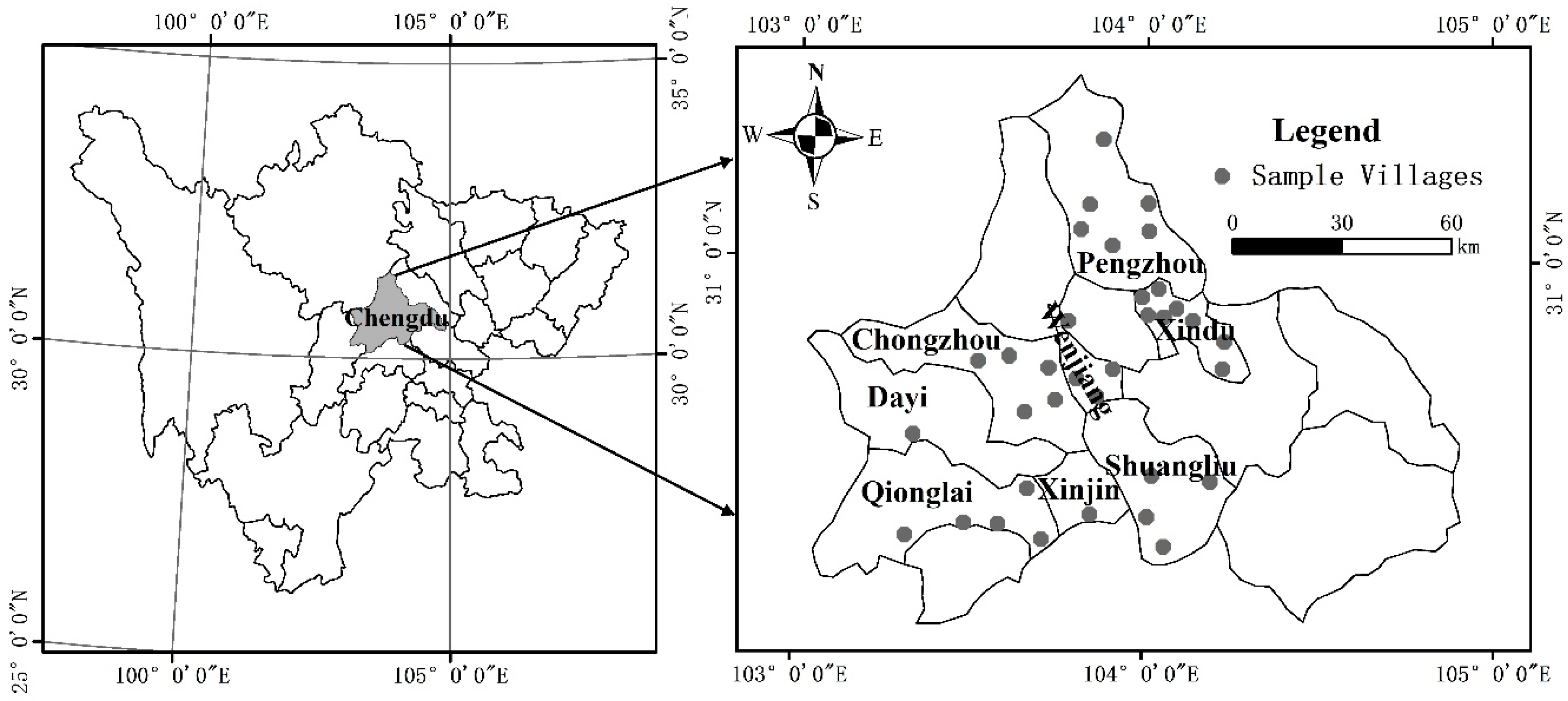
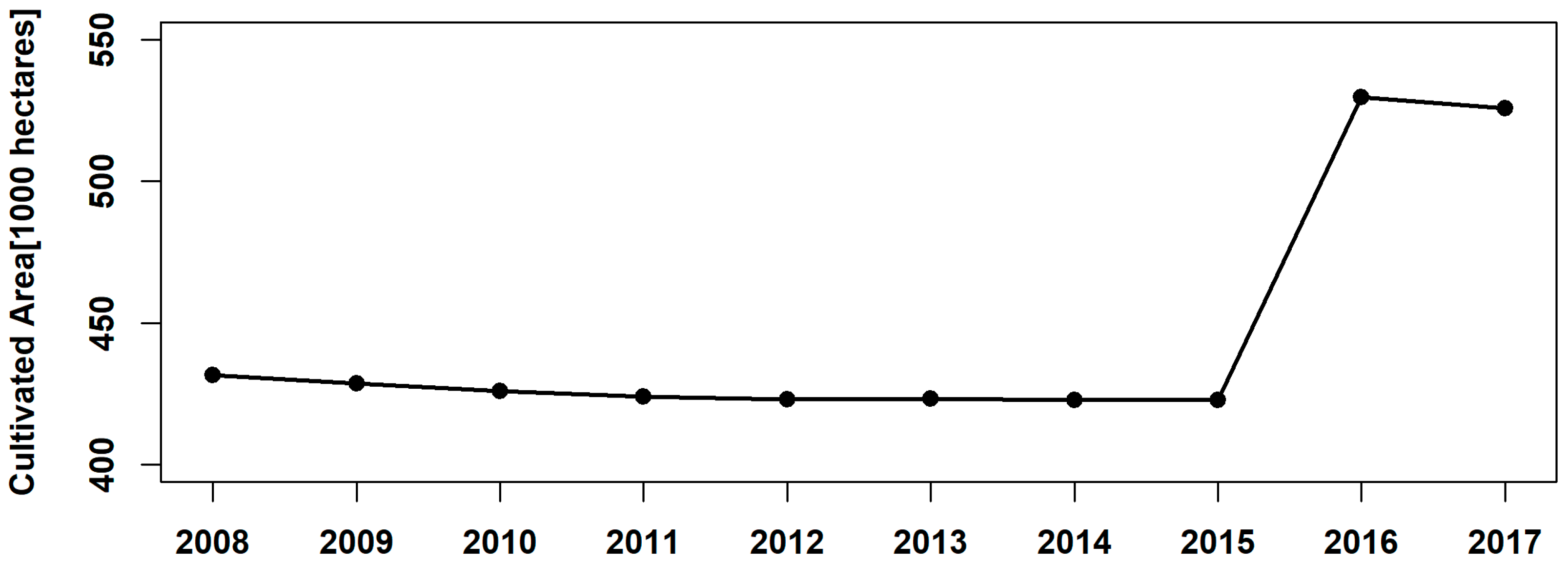

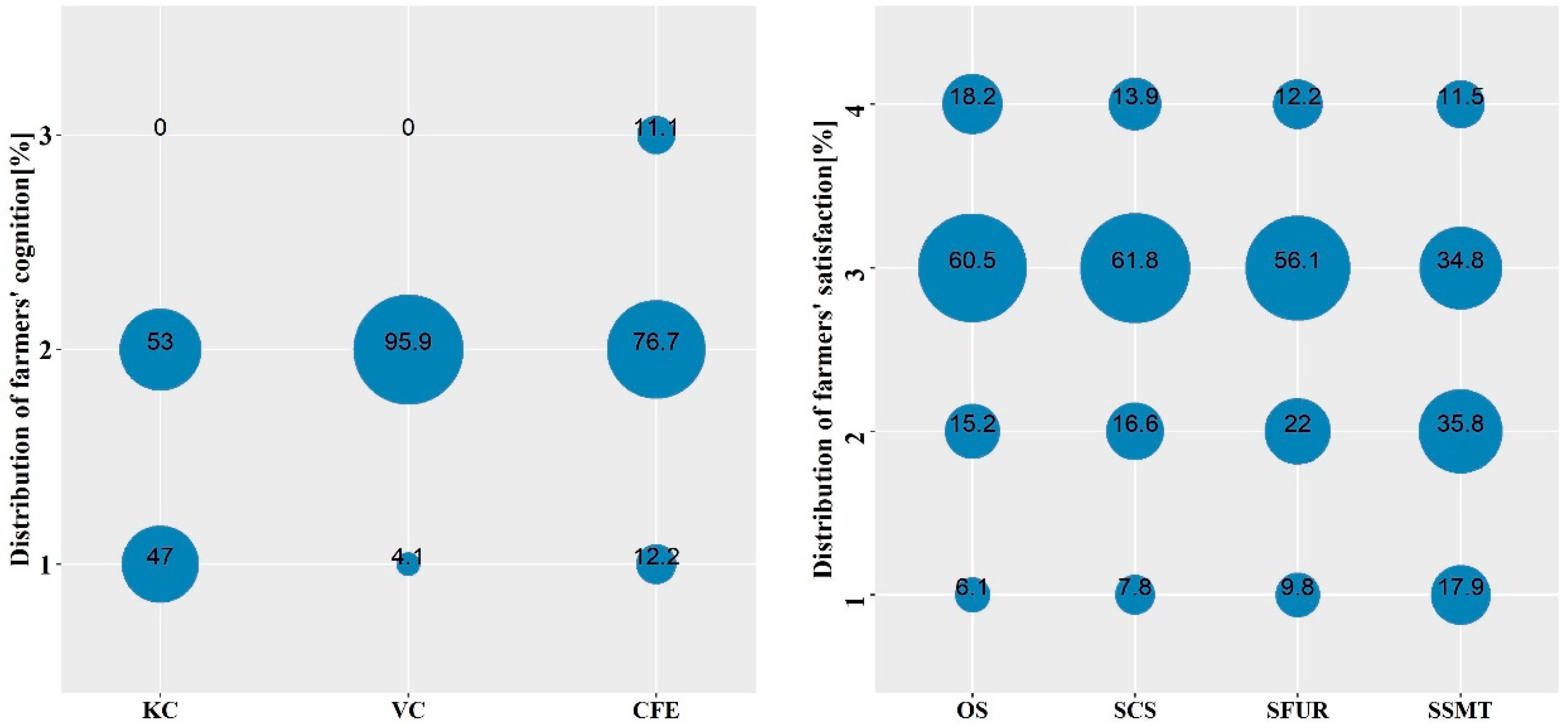
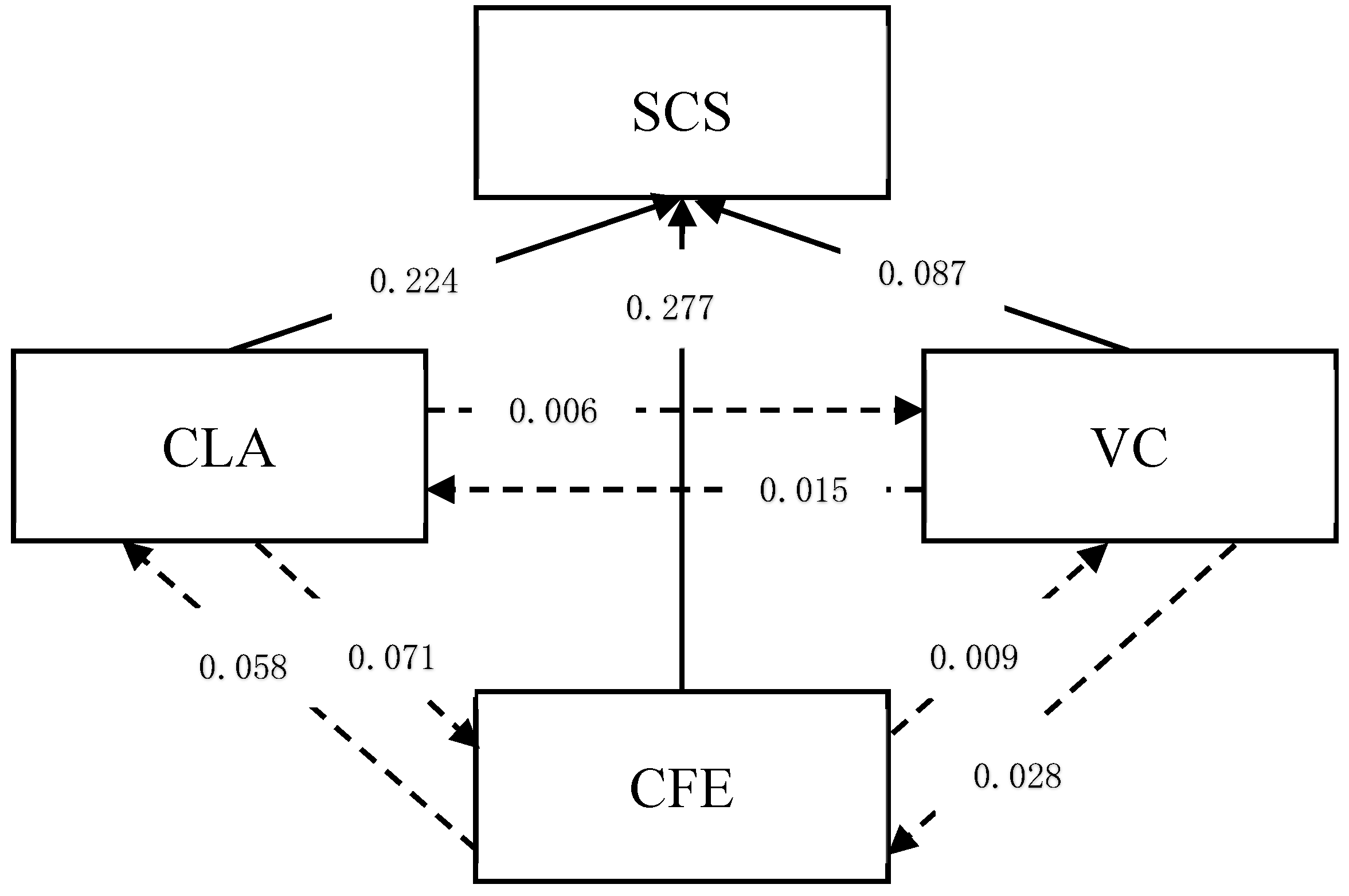
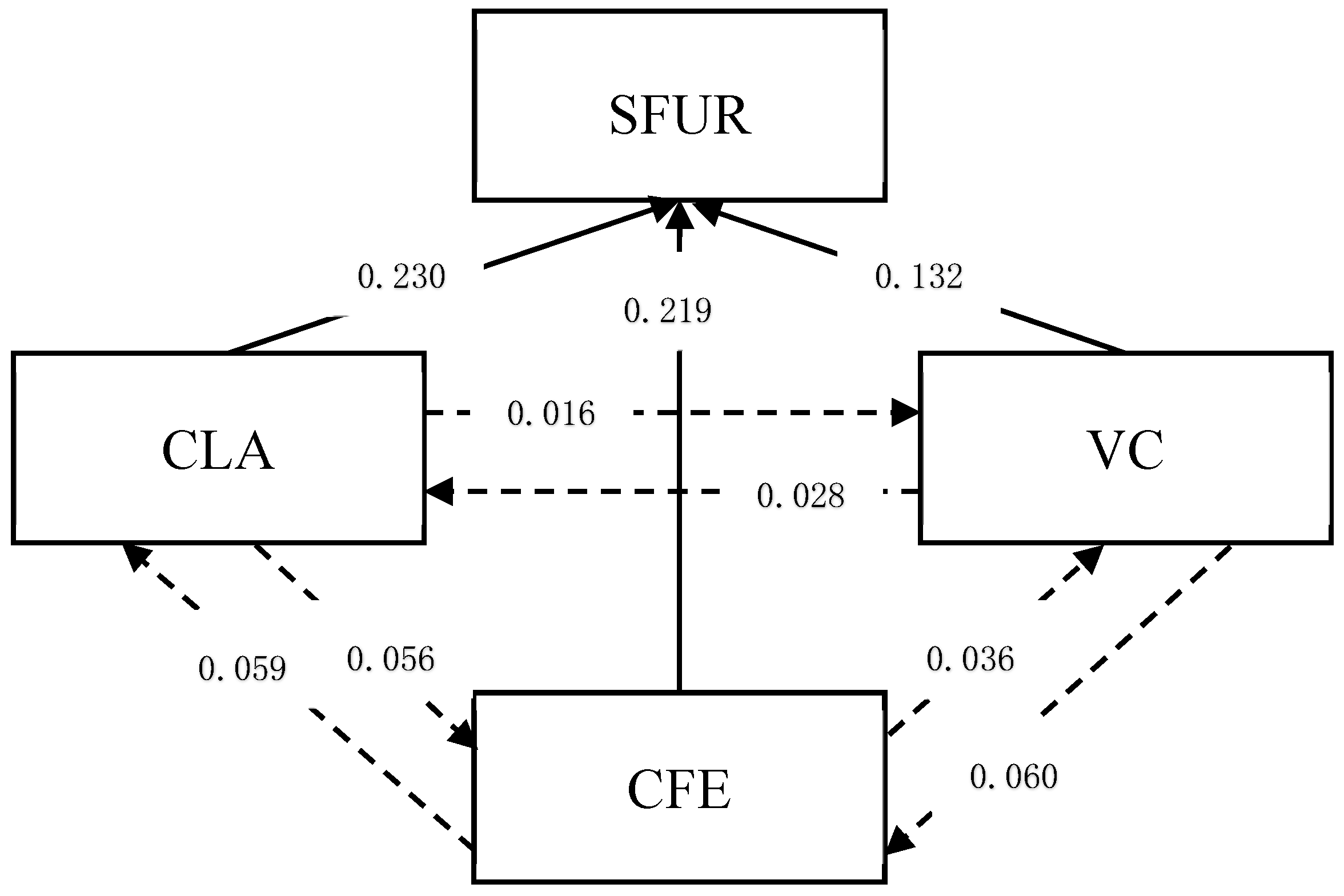
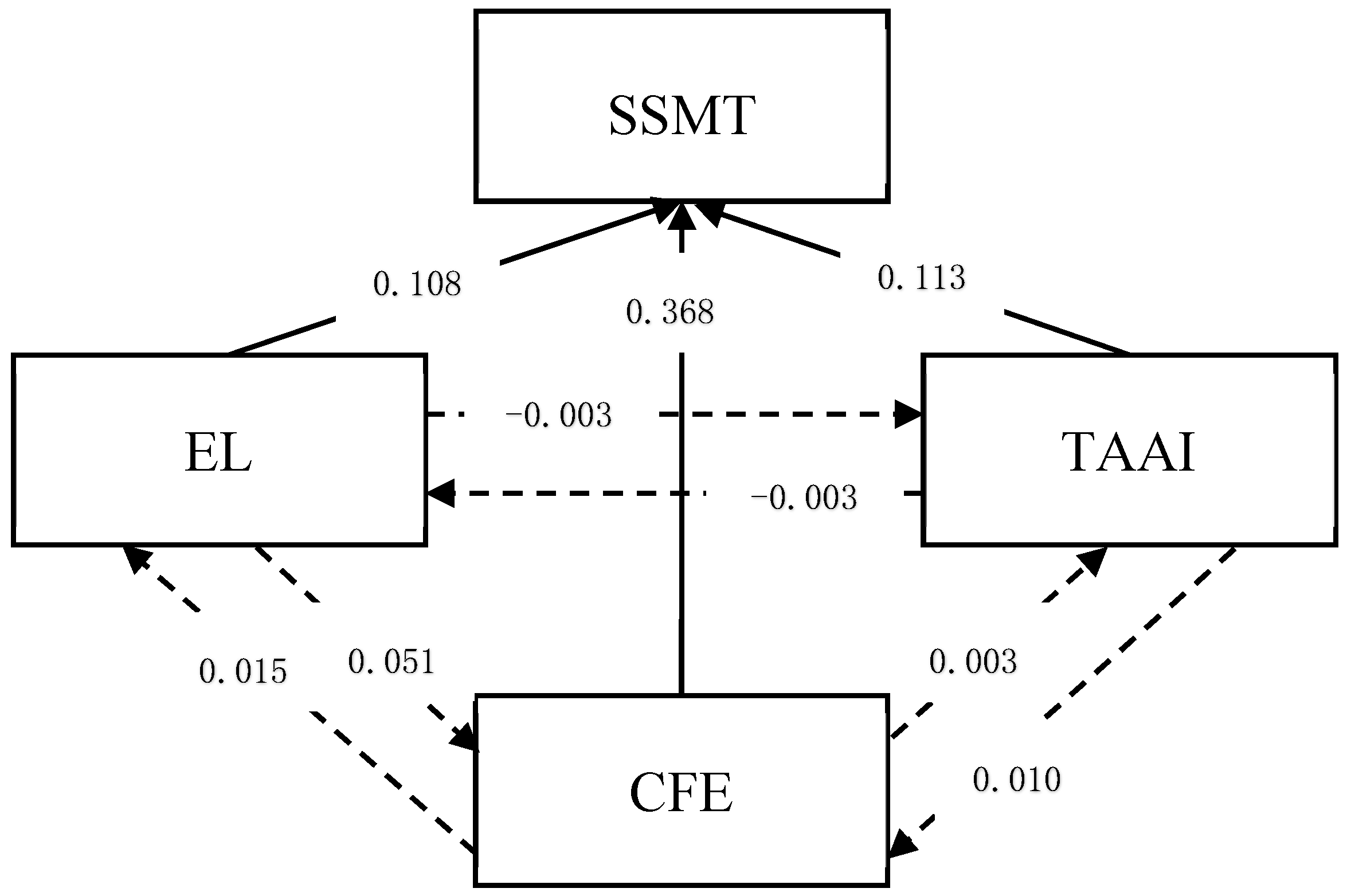

| Item | Contents |
|---|---|
| Implementation date | 2008 |
| Who will pay | Municipal and county governments |
| Who will accept | Farmers and village collective |
| Sources of funds | (1) 5% of land-transferring fees of the local government; (2) total funds of the newly added paid land use fee for the land construction owned by the local government; (3) 50% of the cultivated land occupation taxes used for non-agricultural usage; and (4) 2% of the initial transfer turnover of the collective construction land use rights |
| Compensation standard | 6000 yuan/ha to the basic farmland per year; 4500 yuan/ha to the general cultivated land per year |
| Compensation method | Cultivated land transfer guarantee funds, agricultural insurance subsidy, and pension insurance subsidy |
| Compensation basis | Quality and quantity of cultivated land |
| Funding use requirement | 10% of the total amount of compensation funds should be used for cultivated land transfer guarantee funds and agricultural insurance subsidy, and the remaining 90% should be used for pension insurance subsidy |
| Supervision and management | Compensation funds and farmers’ farmland protection behaviors should be supervised and managed by the government |
| Accounting transparency | The process of fund issuance shall be open to the public |
| Sample Region | Location | Topographic Features | Land Area (km2) | Per Capita Disposable Income of Rural Residents (USD) |
|---|---|---|---|---|
| Wenjiang | 103°41′E-103°55′E; 30°36′N-30°52′N | Plain | 276 | 3847 |
| Xindu | 103°54′E-104°16′E; 30°36′N-30°52′N | Platform | 496 | 3467 |
| Shuangliu | 103°48′E-104°16′E; 30°14′N-30°37′N | Plain, mountain, and hill | 1068 | 3747 |
| Qionglai | 102°54′E-104°53′E; 30°05′N-31°26′N | Plain, mountain, and hill | 1377 | 2815 |
| Chongzhou | 103°07′E-103°49′E; 30°30′N-30°53′N | Plain and mountain | 1089 | 2956 |
| Pengzhou | 103°10′E-103°40′E; 30°54′N-31°26′N | Plain, mountain, and hill | 1421 | 2957 |
| Regional Classification | Survey Counties | Survey Villages | Sample Size |
|---|---|---|---|
| Sample regions with higher economic level | Wenjiang | Tuqiao, Gaoshan, and Hongjiang | 33 |
| Xindu | Jinniu, Guixi, Jiugong, Liangsheng, Shanshui, Yulong, Liyuan, and Tongmeng | 62 | |
| Shuangliu | Kunshan, Wayao, Baiguo, Shilu, and Wenwu | 31 | |
| Xinjin | Guanlin | 9 | |
| Sample regions with lower economic level | Qionglai | Yinghan, Heishi, Gaohe, Quanshui, and Shuangjiang | 46 |
| Dayi | Tongxin | 6 | |
| Chongzhou | Xintao, Chitang, Chongfu, Liba, Gaodun, and Baihe | 60 | |
| Pengzhou | Niuti, Huangzhu, Fengxia, Jingguo, Guangsheng, and Fengquan | 49 | |
| Total | 296 |
| Factors | Items | Description |
|---|---|---|
| Farmers’ characteristics | Gender | Male = 1, female = 0 |
| Age | ≤35 = 1, (35,45] = 2, (45,60] = 3, >60 = 4 | |
| Education level (EL) | 0 school years = 1, 1–6 school years = 2, 7–9 school years = 3, >9 school years = 4 | |
| Family size (FS) | <3 persons = 1, 3 persons = 2, 4 persons = 3, 5 persons = 4, >5 persons = 5 | |
| Labor force size (LFS) | <2 persons = 1, 2 persons = 2, 3 persons = 3, >3 persons = 4 | |
| Cultivated land area (CLA) | ≤0.067 ha = 1, (0.067,0.133] ha = 2, (0.133,0.2] ha = 3, (0.2,0.333] ha = 4, >0.333 ha = 5 | |
| Flowing out of cultivated land area (FOCLA) | None = 1, (0,0.133] ha = 2, (0.133,0.267] ha = 3, others = 4 | |
| Total annual agricultural income (TAAI) | RMB: ≤10,000 = 1, >10,000 = 2 | |
| Farmers’ cognitive characteristics of the policy | Knowledge of the CLPF (KC) | I know about the role of cultivated land protection fund: Know a little = 1, know it very well = 2 |
| Value cognition of the CLPF (VC) | I think it is meaningful to implement cultivated land protection fund: No = 1, yes = 2 | |
| Changes in family economic (CFE) | I think there is a promotion in my family’s economic level: No = 1, a little = 2, much = 3 | |
| Overall satisfaction (OS) | I am satisfied with the cultivated land protection fund in general: Dissatisfied = 1, undecided = 2, satisfied = 3, strongly satisfied = 4 | |
| Satisfaction with compensation standard (SCS) | I am satisfied with the compensation standards: Dissatisfied = 1, undecided = 2, satisfied = 3, strongly satisfied = 4 | |
| Satisfaction with funding use requirement (SFUR) | I am satisfied with the funding use requirements: Dissatisfied = 1, undecided = 2, satisfied = 3, strongly satisfied = 4 | |
| Satisfaction with supervision management transparency (SSMT) | I am satisfied with the supervision management transparency: Dissatisfied = 1, undecided = 2, satisfied = 3, strongly satisfied = 4 |
| Variable | Mean | Standard Deviation | Minimum | Maximum |
|---|---|---|---|---|
| Gender | 0.497 | 0.501 | 0 | 1 |
| Age | 3.061 | 0.907 | 1 | 4 |
| Education level (EL) | 2.389 | 0.816 | 1 | 4 |
| Family size (FS) | 3.436 | 1.186 | 1 | 5 |
| Labor force size (LFS) | 2.838 | 0.968 | 1 | 4 |
| Cultivated land area (CLA) | 3.145 | 1.233 | 1 | 5 |
| Flowing out of cultivated land area (FOCLA) | 1.861 | 1.063 | 1 | 4 |
| Total annual agricultural income (TAAI) | 1.196 | 0.398 | 1 | 2 |
| Influencing Factors | Satisfaction with Compensation Standard (SCS) | Satisfaction with Funding Use Requirement (SFUR) | Satisfaction with Supervision Management Transparency (SSMT) |
|---|---|---|---|
| Gender | 0.025 | 0.019 | −0.004 |
| Age | 0.055 | 0.034 | −0.029 |
| Education level (EL) | 0.120 * | 0.107 | 0.156 ** |
| Family size (FS) | −0.099 | −0.082 | −0.058 |
| Labor force size (LFS) | 0.010 | 0.095 | 0.070 |
| Cultivated land area (CLA) | 0.302 ** | 0.302 ** | 0.178 ** |
| Flowing out of cultivated land area (FOCLA) | 0.065 | 0.067 | 0.033 |
| Total annual agricultural income (TAAI) | 0.118 * | 0.128 * | 0.120 * |
| Knowledge of the CLPF (KC) | 0.165 ** | 0.220 ** | 0.204 ** |
| Value cognition of the CLPF (VC) | 0.131 * | 0.117 * | 0.071 |
| Changes in family economic (CFE) | 0.344 ** | 0.314 ** | 0.386 ** |
© 2019 by the authors. Licensee MDPI, Basel, Switzerland. This article is an open access article distributed under the terms and conditions of the Creative Commons Attribution (CC BY) license (http://creativecommons.org/licenses/by/4.0/).
Share and Cite
Xiao, D.; Niu, H.; Fan, L.; Zhao, S.; Yan, H. Farmers’ Satisfaction and its Influencing Factors in the Policy of Economic Compensation for Cultivated Land Protection: A Case Study in Chengdu, China. Sustainability 2019, 11, 5787. https://doi.org/10.3390/su11205787
Xiao D, Niu H, Fan L, Zhao S, Yan H. Farmers’ Satisfaction and its Influencing Factors in the Policy of Economic Compensation for Cultivated Land Protection: A Case Study in Chengdu, China. Sustainability. 2019; 11(20):5787. https://doi.org/10.3390/su11205787
Chicago/Turabian StyleXiao, Dongyang, Haipeng Niu, Liangxin Fan, Suxia Zhao, and Hongxuan Yan. 2019. "Farmers’ Satisfaction and its Influencing Factors in the Policy of Economic Compensation for Cultivated Land Protection: A Case Study in Chengdu, China" Sustainability 11, no. 20: 5787. https://doi.org/10.3390/su11205787
APA StyleXiao, D., Niu, H., Fan, L., Zhao, S., & Yan, H. (2019). Farmers’ Satisfaction and its Influencing Factors in the Policy of Economic Compensation for Cultivated Land Protection: A Case Study in Chengdu, China. Sustainability, 11(20), 5787. https://doi.org/10.3390/su11205787






